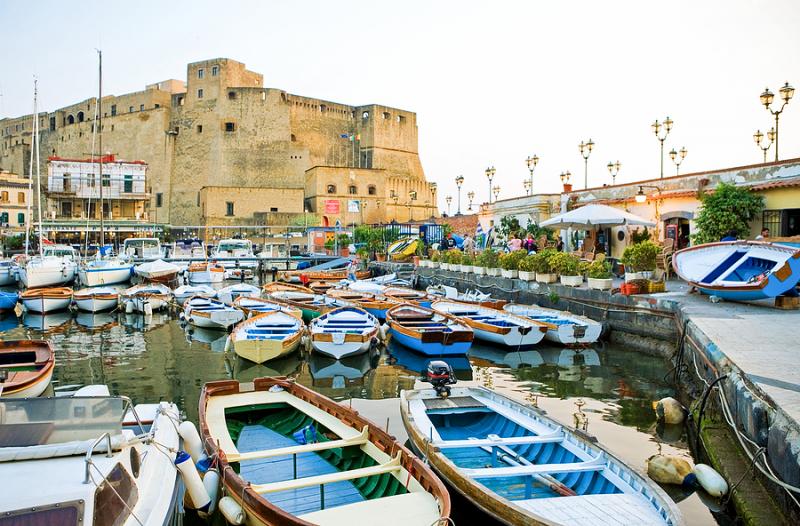The best way to see Naples is on foot, and there’s a lot you can discover in a day, as many of the city’s attractions are located close to one another.
Here’s a walking tour of Naples in a day.
Start at the city’s central railway station, Piazza Garibaldi, which is where you arrive if, for example, you’re getting to Naples from Rome for the day. From the station, take Corso Umberto I, one of Naples’ busiest shopping streets. Then, turning slightly to the right, you reach Via Duomo, your first stop to see the Cathedral of Naples. You’re in the very heart of the historic center.
This is a church that is very dear to Neapolitans as it is dedicated to the cult of San Gennaro, patron saint of the city, and it guards the ‘Treasure of San Gennaro’. But first, take a moment to admire the majestic facade.
The Treasure of San Gennaro is kept in the Museum dedicated to the Saint inside the Cathedral. The museum contains relics, precious objects, statues, candlesticks and silver coins, which devotees have jealously protected during the numerous looting of the city over the centuries. The church houses a vial of what is thought to be the blood of San Gennaro, and it is brought out three times a year, when the miracle of San Gennaro is expected, that is that the dried blood liquefies. If that doesn’t happen, then legend has it that disaster will befall Naples.
But there’s more to the Cathedral than San Gennaro. Inside, you can also admire the chapels built over the centuries by powerful Neapolitan families, as well as paintings by Luca Giordano depicting the Apostles, the Fathers and the Doctors of the Church.

Continue on to Spaccanapoli, perhaps the most famous street in Naples. The name comes from the fact that this street literally ‘splits’ the historic center of Naples in two parts (spacca = splits). In Spaccanapoli, you will find ancient buildings and churches enveloped in legend, interspersed with the unmistakable scent of Neapolitan cuisine. Indeed, Spaccanapoli features some of the best bars, pizzerias, pastry shops and small restaurants where you can try typical Neapolitan food.
Among the attractions not to miss in Spaccanapoli are the Piazza and Church of Gesù Nuovo, the monumental complex of Santa Clara, Piazza San Domenico Maggiore, the Sansevero Chapel with the Veiled Christ, Piazzetta Nilo, San Gregorio Armeno, especially famous for its artisans, the Basilica of San Lorenzo Maggiore, and Underground Naples.
The Veiled Christ is one of the most fascinating and mysterious attractions in Naples. According to legend, the veil of marble on the body of Christ is actually a veil of fabric, transformed into rock by a concoction invented by an illustrious alchemist, the sinister Prince of San Severo. A more realistic theory attributes the effect to the talent of Giuseppe Sanmartino, the sculptor of the Veiled Christ.
As for Underground Naples, its origins date back several centuries, when tuff stone was extracted as building material, thus leading to the creation of an enormous network of tunnels and caves that ended up being used by Neapolitans in different eras.
Today, you can visit Underground Naples via two main routes: from Via dei Tribunali, you access the classic route that crosses the Greco-Roman aqueduct, the air-raid shelters, the War Museum, the underground gardens and the Arianna seismic station. Or you can visit the Roman Theater, which is accessed from a private house by moving a bed under which a door is hidden.
Continue on to Piazza del Plebiscito, one of the landmark squares of Naples. Over the centuries, it has transformed from a simple country road into a meeting place for Neapolitans, a large pedestrian square, surrounded by the neoclassical colonnade of the Church of San Francesco di Paola and the Royal Palace of Naples, built in the late 1500s to host King Philip III. The construction was commissioned to Domenico Fontana in 1600, who delivered it in just two years. Inside the Palace, the highlights are the Royal Apartment, the Royal Chapel, the gardens and the Court Theater.

Naples has four important castles built in different historical periods. On your walking tour of Naples, you can visit two: Maschio Angioino and Castel dell’Ovo.
Maschio Angioino, also known as Castel Nuovo, is a medieval castle built in 1266 by Charles I of Anjou. The fortress was built to become the royal residence for the rulers of the House of Anjou, and was called ‘Castrum novum’, to distinguish it from the three already existing castles, Castel Sant’Elmo, Castel dell’Ovo and Castel Capuano.
Castel dell’Ovo is a seaside castle located on the peninsula of Megaride, an enchanted place that offers a marvelous view of the Gulf of Naples and is the perfect way to wrap up your day visit of the city.
Castel dell’Ovo is located in a very beautiful area of Naples, near via Caracciolo where, in summer, you can see Neapolitans sunbathing and diving into the sea, right near the castle, while enjoying one of the most beautiful views you get in Naples.












